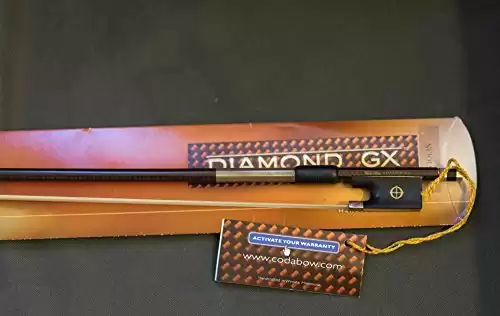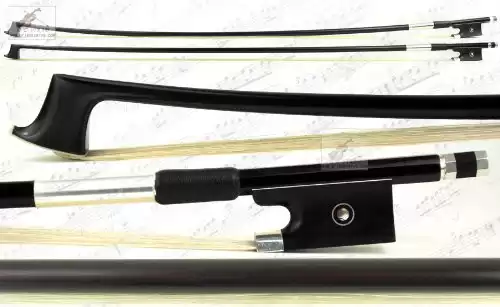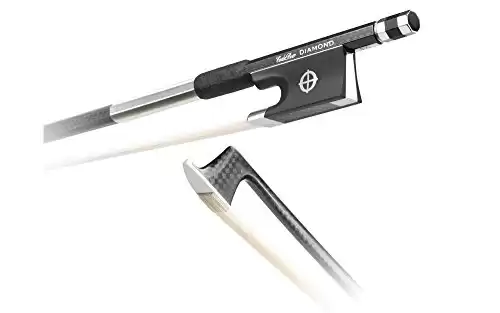The cheapest way to upgrade your sound on a stringed instrument is to invest in a better bow. With some options priced around $20 online today, it seems like you’re getting an excellent deal for practicing your instrument.
If you put a little more into the bow you need, you’ll find the tone and quality improve tremendously with this investment.
When you’re using a professional bow for your violin, cello, or a similar instrument, it’s likely better to rehair the piece to continue enjoying its quality.
Should I Rehair a Violin Bow or Invest in a New One?
The average student should only need to have their bow rehaired about once every 12-24 months. It can even be longer than that in some situations. Professionals should consider this action every 2-6 months. If you use a cheap bow (around $50), it’s easier to replace it.
If you’re wondering whether you should rehair your bow or invest in a new one, several questions are worth asking to determine which option is best for your needs.
- How much did you spend on the bow that requires rehairing?
- Do you love the bow more than anything else you have in your collection?
- Is there a luthier in your community who can rehair the bow for you?
- Do you know how to rehair a bow at home?
Since the cost of a new bow on the lower end of the pricing spectrum is often less than what a luthier charges to rehair one, you’re usually better off purchasing a replacement.
You could then repurpose your previous bow in different ways. It could become a practice component, especially if you want to improve your agility.
If you find that you’re going through the bow faster than you’d prefer, consider purchasing one made with synthetic hair instead. It will last longer, especially for students who work on their instruments daily.
When Do I Need to Rehair My Bow?
Although the average student only needs to rehair their bow about one per year (or every other year), it is still essential to know the signs and symptoms of when this task is necessary.
Here are the standard signs that you can see to indicate that it is time to rehair or replace your bow.
- More of the hairs are broken on one side of the bow than the other because of uneven tension. If you see this symptom, you’ll want the bow inspected to determine if it has warped.
- You see hair loss happening in the middle, which indicates that too much pressure is getting placed on the hairs while playing.
- Every bow eventually gets discolored, sticky, and smelly. This outcome happens because of skin residue, dust, grime, and rosin mixing together. You can prevent this issue by cleaning your bow each time you play, just as you would with your instrument.
Unless you have training as a luthier, it is better to have the rehairing process completed by a professional.
If you’re using a cheap bow for your instrument, it’s probably better to buy a new one.
Best Bows to Use for Your Violin
When you’re ready to take your playing quality to the next level, you’ll eventually need to purchase a premium-quality bow. These are the best options that are available right now for you to consider.
1. CodaBow Diamond GX
This 4/4 violin bow comes with a Kevlar acoustic core to ensure you receive a world-class sound with each movement.
It also incorporates a traditional frog from polished ebony by Walter Paulus.
Each one is individually numbered and made by hand in the United States.
| Benefits of Using the CodaBow Diamond GX | Disadvantages of Using the CodaBow Diamond GX |
| You receive a limited lifetime warranty for this bow when you purchase it from an authorized dealer. | The limited lifetime warranty for the bow only applies to its first owner. |
| The performance you receive with this item is similar to the best Pernambuco bows in the past. | Although some students might benefit from this product, it is directed more toward advanced learners, orchestra players, or professionals. |
| It uses first-selection stallion hair from white horses only without bleaching to ensure a consistent performance occurs. | |
| The bow is well-balanced, lightweight, and provides excellent control. |
Since the CodaBow Diamond GX uses a carbon-fiber design, you can avoid the issues with temperature and humidity that often impact other bows.
You probably won’t find a better product on the market than this one.
2. D Z Strad Violin Bow
This Peccatte copy is a delightful reproduction of the master bowmaker’s work.
You’ll appreciate the silver-lined design immediately, with only the highest-quality Pernambuco used to create a dense surface that provides a positive outcome for any playing style.
| Benefits of Using the D Z Strad Violin Bow | Disadvantages of Using the D Z Strad Violin Bow |
| The thumb grip on this bow comes wrapped in lizard skin leather, on top of the silver lapping, to ensure you have a secure experience. | You’ll need to maintain a specific environment for the bow to help it retain its quality. |
| The manufacturer only uses Grade AAAA Mongolian horsehair for the playing service. | The horsehair tends to break somewhat readily, which means you’ll need a luthier you trust near your home. |
| It uses an ebony frog with mother-of-pearl inlays and slides to deliver an evenly balanced performance in any conditions. |
When you select the D Z Strad Peccatte copy, you might not be getting a master antique, but it will feel like it!
It’s a premier choice for any professional player who wants only the most delicate sounds to come from their instrument.
3. D Z Strad Snakewood 4/4 Violin Bow
If you prefer a stiff bow that delivers a fast response, the D Z Strad Snakewood 4/4 violin bow offers a beautiful experience to consider.
It’s created in the Baroque style to provide another grip element while creating a forgiving playing experience suitable for all players.
| Benefits of Using the D Z Strad Snakewood Bow | Disadvantages of Using the D Z Strad Snakewood Bow |
| This bow provides an excellent mid-range option for students who want to take their skills to the next level. | It might not stand up to the rigors of regular professional performances. |
| It uses only unbleached white Mongolian horsehair with AAA grading. | The price is right in the range where it might be cheaper to buy a new bow than rehair this one when the time comes for a repair. |
| The traditional frog is made from premium snakewood to deliver a polished, handsome result. | |
| It provides a lightweight playing experience that’s well-suited to younger players especially. |
Some people love the Baroque style for a violin bow, while others are not partial to it. If you’ve never played with this design before, I’d highly recommend testing one out before the purchase.
- Size: 4/4
- Kevlar Acoustic Core
- Nickel Silver Fittings
- Handcrafted in the USA
4. CodaBow Diamond SX Bow
If you prefer something sturdier for an advanced student, the CodaBow Diamond SX is an excellent choice.
It uses engineered ebony and a Kevlar acoustic core with a graphite diamond weave finish to deliver incredible results.
This option could be the first bow you would own that needs rehairing instead of replacement.
| Benefits of Using the CodaBow Diamond SX | Disadvantages of Using the CodaBow Diamond SX |
| This 4/4 violin bow uses a simulated ivory tip plate instead of a plastic piece like cheaper models to provide a durable experience. | The bow uses a handcrafted design for the finishing process, which means the wedges and plugs can have some variability. |
| It uses a Moroccan leather grip for extra traction while playing, highlighted by nickel silver fittings for excellent aesthetics and balance. | It is priced above the comfort zone for some beginners who are unsure if they want to stick with the violin. |
| The original owner receives a 10-year limited warranty with purchase. | |
| It features a natural graphite tint that delivers a modern style that still works well for traditional techniques. |
If you are using a Pernambuco bow today as a teacher, orchestra professional, or touring musician, it might be time to keep it in its case.
You receive superior sound quality for one-fifth of the price, ensuring that this investment is one of the best you ever make for your musical career.
Should I Rehair My Bow or Buy a New One?
If you select one of the bows from this guide, my recommendation would be to rehair your bow. You’ll want to take it to a luthier you trust for that process unless you have the confidence to do the work yourself.
Since most luthiers won’t take projects for cheaper bows because of the likelihood the product could break, you’re better off buying a new one whenever it is less than $50 to replace.
Depending on your home luthier, I can see that price rising to $200 or more for some bows.
If you’re concerned about durability for a young student, I’d recommend finding a bow with synthetic fibers to use. When you’re ready to take your tone to the next level, these are the best new bows to buy today.





